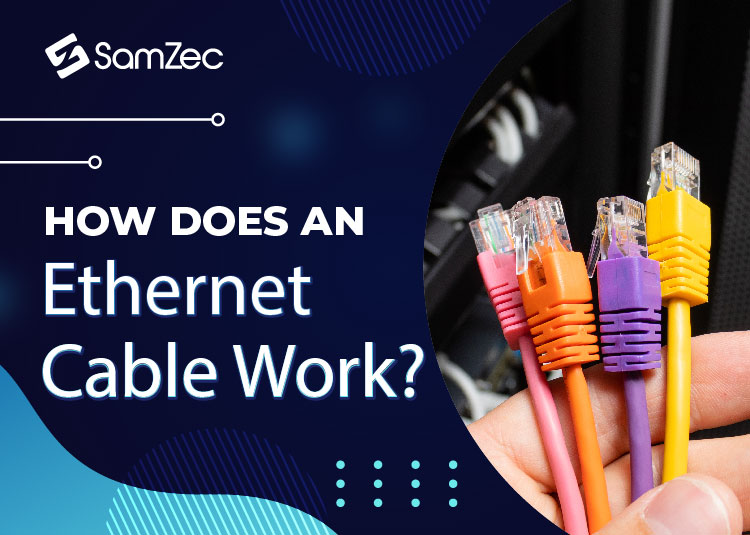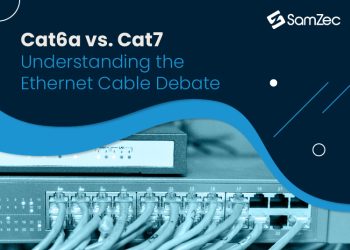To ask if you have ever used the internet would be a silly question. So we would assume with confidence that not only have you used the internet in the past, but you are using it right now, as you read this blog. Now it is most likely that your internet connection has been made possible by an Ethernet cable.
Ethernet cables are the backbone of local area networks as well as wide area networks. Without ethernet cables, almost the entire internet infrastructure around the globe would fall apart.
Fun Fact: Twisted-Pair Ethernet network cables are also known as low-voltage cables because data is transmitted across devices in the form of low-voltage current.
Ethernet network cables, also known as network cables are cords that connect compatible electronic devices to modems, routers, switches, servers, and to other devices. Ethernet cables essentially work as the bridge between different electronic devices in a Local Area Network (LAN).
What is Ethernet and How does it Work?
To understand how an ethernet cable works, you first need to know what ethernet technology is and how it functions.
In LAN networks, ethernet allows data to be shared among multiple devices at high speeds. It uses the IP address of the devices to deliver and send data packets. That is why every device that is capable of utilizing ethernet technology must have a unique IP address.
Put another way, ethernet technology is like a courier system. But instead of physical packages, it transports data packets from one device to another. The IP addresses of the devices are literally like addresses. Moreover, IP addresses can be assigned manually or automatically upon connecting to a local area network.
To transfer data, ethernet technology breaks it into small packets. These data packets are easier to transmit across network cables and those that get lost can be sent again without having to send the entire batch.
Ethernet Cable: What does it do?
What is an ethernet cable? Well, ethernet cables are cords that are used to connect devices in local area networks. The IEEE has set standards for ethernet and ethernet cables are produced as per these standards.
As mentioned earlier, most of the data communications in local area networks are done via ethernet cables. Moreover, these cables are also used for power over ethernet applications. For instance, if you need to connect your PoE-enabled IP security cameras to a DVR, you will need to use a copper ethernet cable. Similarly, ethernet cables are used to connect routers, hubs, modems, switches, PCs, smart TVs, Audio/Video devices, gaming consoles, etc
Ethernet Adapters
To use ethernet cables, you need to connect one end of the ethernet cables in your device and the other end to a router or switch. If your device does not have an ethernet port, you can use an ethernet adapter. Ethernet adapters are small and affordable devices that allow you to connect ethernet cables to your devices through a USB port.
How do Ethernet Cables work?
Ethernet cables work in two different ways. First, once they are connected between two devices, they transfer data from one another. This transference of data is achieved by breaking it down into smaller packets at the end of the sender and once again put together at the receiver’s end.
And the second way ethernet cables work is by allowing wireless routers to broadcast their signals. The wireless connections in local area networks are also supported by ethernet cables at the back end. Without them, the router would not be able to send or receive data packets.
Best Ethernet Cables to Buy
The following are the top-selling twisted-pair ethernet cables.
Cat5e Cable
- Speed: 100 MBit/s
- Frequency:350 MHz
- Conductors: Purer Copper and Copper-Clad Aluminum
- Jackets: Plenum, Riser, and PVC.
Cat6 Cable
- Speed: 1 GBit/s
- Frequency: 550 MHz
- Conductors: Pure Copper and Copper-Clad Aluminum
- Jackets: Plenum, Riser, PVC, LLDPE
Cat6a Cable
- Speed: 10 GBit/s
- Frequency: 750 MHz
- Conductors: Pure Copper
- Jackets: Plenum, Riser, LLDPE
Conclusion
In short, an ethernet cable connects devices in a local area network and provides the medium for the transfer of data. Devices break down data into small packets and transmit it across networking cables in the form of electrical signals.
FAQs
What is Ethernet?
Just like you have mailing systems in cities to send and receive packages, you have ethernet in Local Area Networks to send and receive data. In other words, Ethernet technology is a mode of communication between different devices.
Is ethernet faster than WiFi?
Yes. Ethernet cables are generally faster than WiFi. In addition to that, Ethernet Cables are more secure.
How does an ethernet cable operate?
Ethernet Cables have metal conductors at their core. Data is broken down into packets and transmitted across the cables as low voltage electrical current. This low-voltage current is converted back into data by the receiving device.
Do you connect ethernet to a modem or router?
If you do not have a modem-router combo, you will need to connect the ethernet cable with both the modem and the router. First, connect the incoming cable to the modem. Then connect one end of another ethernet cable with the modem and the other end with the router. The router will provide wireless signals.




















